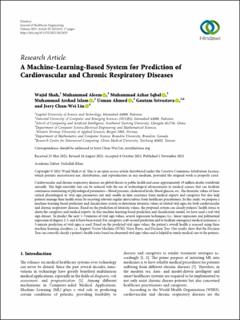| dc.contributor.author | Shah, Wajid | |
| dc.contributor.author | Aleem, Muhammad | |
| dc.contributor.author | Iqbal, Muhammad Azhar | |
| dc.contributor.author | Islam, Muhammad Arshad | |
| dc.contributor.author | Ahmed, Usman | |
| dc.contributor.author | Srivastava, Gautam | |
| dc.contributor.author | Lin, Jerry Chun-Wei | |
| dc.date.accessioned | 2022-03-14T12:44:09Z | |
| dc.date.available | 2022-03-14T12:44:09Z | |
| dc.date.created | 2021-12-24T23:30:35Z | |
| dc.date.issued | 2021 | |
| dc.identifier.citation | Shah, W., Aleem, M., Iqbal, M. A., Islam, M. A., Ahmed, U., Srivastava, G., Lin, J.C.-W. (2021). A Machine-Learning-Based System for Prediction of Cardiovascular and Chronic Respiratory Diseases. Journal of Healthcare Engineering, 2021:2621655. | en_US |
| dc.identifier.issn | 2040-2295 | |
| dc.identifier.uri | https://hdl.handle.net/11250/2985077 | |
| dc.description.abstract | Cardiovascular and chronic respiratory diseases are global threats to public health and cause approximately 19 million deaths worldwide annually. This high mortality rate can be reduced with the use of technological advancements in medical science that can facilitate continuous monitoring of physiological parameters—blood pressure, cholesterol levels, blood glucose, etc. The futuristic values of these critical physiological or vital sign parameters not only enable in-time assistance from medical experts and caregivers but also help patients manage their health status by receiving relevant regular alerts/advice from healthcare practitioners. In this study, we propose a machine-learning-based prediction and classification system to determine futuristic values of related vital signs for both cardiovascular and chronic respiratory diseases. Based on the prediction of futuristic values, the proposed system can classify patients’ health status to alarm the caregivers and medical experts. In this machine-learning-based prediction and classification model, we have used a real vital sign dataset. To predict the next 1–3 minutes of vital sign values, several regression techniques (i.e., linear regression and polynomial regression of degrees 2, 3, and 4) have been tested. For caregivers, a 60-second prediction and to facilitate emergency medical assistance, a 3-minute prediction of vital signs is used. Based on the predicted vital signs values, the patient’s overall health is assessed using three machine learning classifiers, i.e., Support Vector Machine (SVM), Naive Bayes, and Decision Tree. Our results show that the Decision Tree can correctly classify a patient’s health status based on abnormal vital sign values and is helpful in timely medical care to the patients. | en_US |
| dc.language.iso | eng | en_US |
| dc.publisher | Hindawi | en_US |
| dc.rights | Navngivelse 4.0 Internasjonal | * |
| dc.rights.uri | http://creativecommons.org/licenses/by/4.0/deed.no | * |
| dc.title | A Machine-Learning-Based System for Prediction of Cardiovascular and Chronic Respiratory Diseases | en_US |
| dc.type | Peer reviewed | en_US |
| dc.type | Journal article | en_US |
| dc.description.version | publishedVersion | en_US |
| dc.rights.holder | Copyright © 2021 Wajid Shah et al. | en_US |
| dc.source.volume | 2021 | en_US |
| dc.source.journal | Journal of Healthcare Engineering | en_US |
| dc.identifier.doi | 10.1155/2021/2621655 | |
| dc.identifier.cristin | 1971973 | |
| dc.source.articlenumber | 2621655 | en_US |
| cristin.ispublished | true | |
| cristin.fulltext | original | |
| cristin.qualitycode | 1 | |

